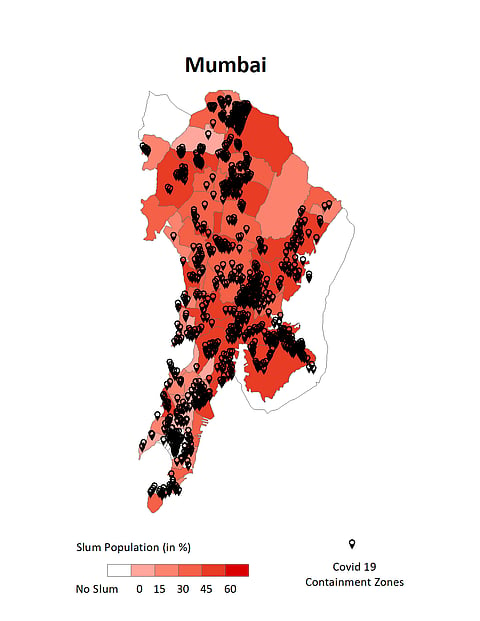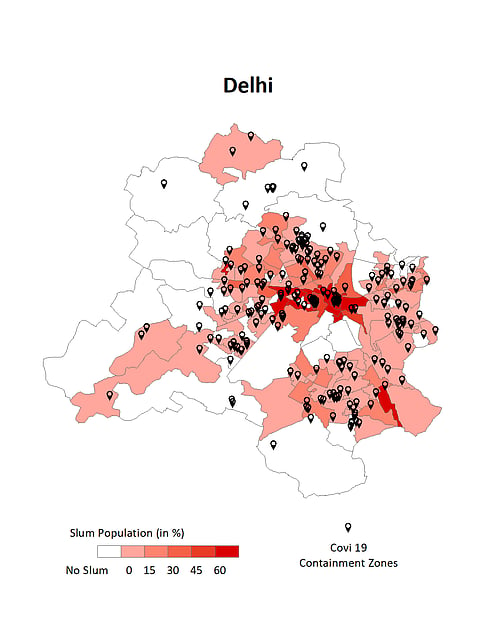As per 2011 Census, there are about 66 million slum inhabitants in India accounting for 5.4 per cent of India’s population and 17.4 per cent of total urban population. There are a multitude of factors that escalate the susceptibility of these informal settlements to Covid-19 infection. The dearth of clean and unshared drinking water and sanitation facilities, inadequate attention to personal hygiene, poor living conditions, food and income insecurity, and lack of access to quality healthcare expose residents in urban slums to significant risk because they ensconce fundamental environmental conditions which foment the contraction and transmission of the disease.
COVID-19: Are Slums In India Conducive For The Outbreak?
Overcrowding in slums makes social distancing and self-quarantine quixotic, and place the slum dwellers at an increased risk of contracting an infection.
To add fuel to the fire, overcrowding in slums makes social distancing and self-quarantine quixotic, and place the slum dwellers at an increased risk of contracting an infection. As countries across the world now feel that living with the coronavirus might become a way of life, it is imperative to account for these limitations before any policy action is formulated for tackling Covid-19 in such settlements. This article analyses four variables namely, number of persons per room used for sleeping, availability and type of toilet facility and water source, and access to soap and water for washing hands to rate the susceptibility of slums to coronavirus in these four mega cities.
According to recent data, about 45 per cent of currently active coronavirus cases (as of June 16) have been reported from three mega-cities, with Mumbai, Delhi and Chennai contributing around 18, 17 and 10 per cent respectively to the active case burden in India. While in terms of overall confirmed cases, Mumbai has reported more cases and deaths than the other two put together. Chennai's burden of cases proportionate to its population is higher than that of Delhi. Another mega city that has been sitting on the coronavirus time-bomb is Kolkata. With a frail healthcare system and a burgeoning disease burden, it is only a matter of time before the healthcare systems in Kolkata spiral down towards a complete collapse.
Figure 1A: Households by persons per room used for sleeping (in %) |
Figure 1B: Households by type of toilet facility (in %) |
Figure 1C: Households by location of main water source (in %) |
Figure 1D: Households by access to water and soap (in %) |
It is evident that a greater proportion of slum residents share room with at least three people for sleeping. This is an indication of the fact that there is an inherent overcrowding in slums in the four mega cities under consideration here. Also, higher percentage of slums in all the four cities have shared toilets, with Kolkata and Mumbai having the highest and the second highest percentage of shared toilets in slums respectively. A sizeable proportion of slums in Delhi and Mumbai have no toilet facility and people use open spaces for the purpose.
A considerably lower proportion of slum households in Delhi and Kolkata have their main source of water located within the yard, while the proportion is quite impressive for Mumbai and Chennai. While a considerable proportion of both slum and non-slum households have access to soap and water for washing hands, the proportion is comparatively lower for slum households, with the proportion being lowest for Chennai, followed by Kolkata.
These indicators clearly suggest that there is hardly any space in these settlements to practice social distancing. The conditions of the inhabitants of these slums is much worse when compared to their non-slum counterparts and this factor makes them highly vulnerable to contracting the COVID-19 infection.
Figure 2: Share of slum population and location of containment zones by mega-cities |
(Data Sources: Census of India and Municipal Corporations of respective cities)




A prima-facie view of the bivariate choropleth maps showing the share of slum population across the wards in selected mega cities of India and the location of Covid-19 containment zones reveals that the concentration of slums is the highest in Mumbai, followed by Kolkata and Chennai. When the containment zones in the maps are reviewed with scrutiny, it is observed that with the exception of Chennai, the containment zones are heavily concentrated in areas which have a higher concentration of slums in Mumbai, Delhi and Kolkata. It is also clearly evident that the maximum number of containment zones have been set up in Mumbai, thus, underpinning the fact that slums are at higher risk of being exposed as the hotspots for the coronavirus disease and any measure to tackle the outbreak without ample assiduity to the culpable factors in these informal settlements would not yield benign results.
Figure 3: Projected cumulative COVID-19 cases by mega-cities |
The projected confirmed coronavirus case load in these mega cities using ARIMA modelling shows that while the number of confirmed cased would increase at snail’s pace in Kolkata, the confirmed cases in the other three cities would increase by leaps and bounds, with the rate of increase being the fastest for Mumbai, followed by Delhi. This projection, again, points towards the fact that the concentration of slums has a momentous impact on the number of cases arising from coronavirus.
According to a UNICEF report with the theme "Children in Urban World", India is home to over to 50,000 slums, of which 70 per cent are concentrated in five states of Maharashtra, Andhra Pradesh, West Bengal, Tamil Nadu, and Gujarat. The current coronavirus fiasco only goes on to accentuate the fact that the slum population is the most vulnerable population and, thus, provides the most apposite conditions for the genesis and proliferation of maladies, the situation being even more perilous in the case of communicable diseases.
The current pandemic demands a holistic approach towards the issues faced by the slum population and an increase in the testing rate as well. This will not just aid in identifying the novel cases but also prevent its spread in the adjoining non-slum areas. An example can be taken from Dharavi, the largest slum in Asia, that went from being a coronavirus hotspot to a model for other developing nations grappling with the pandemic. Their chase the virus technique has not only reduced the number of new cases and recovery rate massively but also curtailed the mortality. Dharavi is also the best example of how working with the community can lead to a better strategic management of any issue.
It is noteworthy that for the urban poorest, a massive chunk of who reside in these informal settlements, it is incredibly difficult to follow the norms of social distancing due to space constraints and many other issues. In addition to that, these people are extremely vulnerable as far as their economic security and food security are concerned. Thus, it is not only imperative to focus on the amelioration of testing and screening facilities, but also equally impart importance to the food and income security of the vulnerable population residing in these informal settlements.
Bishwajeet Besra, Nand Lal Mishra and Akancha Singh are research graduates (MPhil in population studies) from International Institute for Population Sciences, Mumbai.
Mahadev Bramhankar is a research graduate (MPhil in Biostatistics and Demography) from International Institute for Population Sciences, Mumbai.
Tags